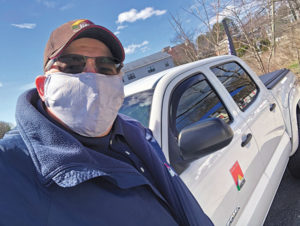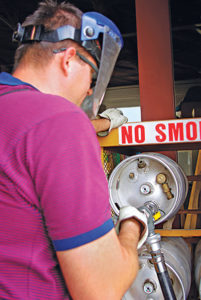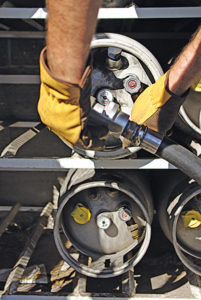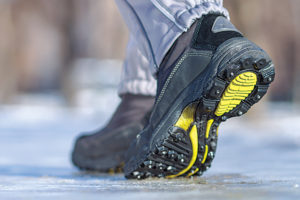COVID-19 adds to the layers of protection propane retailers use in daily operations
Masks may be attracting much of the current face time in popular culture as the coronavirus outbreak sweeps across the country, but propane providers have long been utilizing the latest personal protective equipment (PPE) to keep everybody safe.

A Hocon Gas employee dons a mask during the coronavirus pandemic. Photo courtesy of Hocon Gas
A variety of PPE – with particulars determined by the risks inherent to a specific task – has been routinely applied over the years by an exceptionally safety-conscious industry.
“PPE is important when we can’t avoid contact with, or exposure to, possible hazards,” says Eric Kuster, vice president of safety, education and compliance at the Propane Education & Research Council, where instruction in proper PPE selection and use has a large presence in training programs.
“It’s part of the culture of the industry,” he adds. “Our industry has always been very good about that.”
Assuming they can be obtained amid still-tight availability without depriving local medical personnel, many propane industry members are now routinely wearing masks as they go about their daily business.
And although scientists are still debating the effectiveness of nonspecialized face coverings for protecting the wearer from viral contamination, they are widely credited with shielding bystanders from sprayed spittle – or at minimum donning a mask has become the polite thing to do.
Serving the industry’s designated status as “essential” to the country’s overall interest, the National Propane Gas Association (NPGA) has been working with multiple sources to facilitate PPE provisioning; checking with your distributor will yield precise and timely details.
When the scope of the pandemic was becoming apparent, NPGA officials had “just hours” to notify the Federal Emergency Management Agency (FEMA) of the needs for cloth masks and shipping addresses. More than 57,000 masks destined for 1,200-plus locations were requested, according to Steve Kaminski, NPGA president and CEO. The organization has also been coordinating with Rototherm, a European NPGA member, which is manufacturing face shields for member distributors.
Selecting the proper PPE and mitigating any confusion that may arise requires an analysis of your organization’s actual operational situations and anticipated hazards.

PPE is needed
when employees
cannot avoid exposure
to possible hazards. Photo: Mikefahl/iStock / Getty Images Plus/Getty Images
Paraco Gas has been “ahead of the curve” in embracing the latest standards being implemented in regard to coronavirus concerns and other safety issues, says Dave Latourell, the New York-based company’s director of safety and transportation. He cites as an example a “very interesting challenge during COVID-19 as N95 respirators were being requested and recommended to many; however, many don’t realize an N95 filtering face piece is a respirator – a dust mask is not the same thing.”
Thus, consulting with your distributor can be crucial for establishing the correct PPE purchases. In some circumstances, “it’s just word choice” in discussing PPE. “It means different things to different people,” he says, emphasizing the importance of clarity.
There are numerous available options and applications that Latourell cites:
- Chemical- and temperature-resistant gloves for liquid transfers (monkey grip gloves).
- Elbow-length chemical- and temperature-resistant gloves for liquid propane emergencies.
- Face shields for liquid propane emergencies.
- Hard hats for head protection and to attach face visors as needed.
- Leather and/or mechanic-style gloves for employees to protect against cuts and abrasions.
- Eye protection as needed.
- Respiratory protection (respirators) for employees completing painting duties in cylinder-refurbishing locations.
- Footwear – ankle support, boot height, encouraged safety toe.
All of the front-line Paraco Gas personnel are wearing cloth or disposable face covers. The masks help to make sure that the company is not contributing to a resurgence associated with the coronavirus, Latourell says.
“Our guys are becoming comfortable in the new environment. They’re settling in to the new normal,” he points out, adding that management remains on top of ensuring compliance and encouraging everyone to pay close attention to safety at all times. “We want to make sure people aren’t becoming too complacent.”
Staying sanitary
Blossman Gas, based in Mississippi with 75 locations across the Southeast, has been diligent in ensuring employees have the tools, the PPE equipment and the sanitary products to work safely, says Stuart Weidie, president and CEO.
“All of those things are part of our gas delivery, but also we’re spraying with sanitary products tanks, dome lids, valves and hose end valves before and after every delivery,” he says. “We don’t want to carry something that potentially was contaminated to another location.”
Goggles, face masks, gloves, outer gear and foot booties are supplied, particularly for cases where employees have to enter homes to address emergency situations.

PPE requirements are variable and often depend on the job at hand. Photo: Mikefahl/iStock / Getty Images Plus/Getty Images
“All of our field personnel get a kit that’s got PPE equipment. We’ve been doing that for 30 years. That kit has modified over the years,” Weidie says. “The sanitary aspect has certainly been new this time. That’s nothing that we had considered necessarily in the past as we’ve had to over the last couple of months or so.”
Finding a safer way
When it comes to employee safety and PPE, “I like to believe that most people ‘get it.’ They’ve all been through the training,” observes Mike Walters, vice president of safety and fleet at Superior Energy Systems.
Yet everyone on a propane company’s staff must remain diligent about any hazards that may be present – readily seen or not seen – as people tend to feel that “if it hasn’t happened, I can’t visualize it.” You have to continually pay attention to your surroundings, he says.
While bearing in mind the assorted workplace regulations, Walters stresses that the PPE particulars of your situation are ultimately up to you. Your safety is your responsibility, he says. “Your personal safety belongs to you.” If a job site condition causes a sense of concern, “stop and find a safer way.”
Walters continues by emphasizing that “PPE is task driven,” meaning that choosing a certain type of safety equipment must depend on the specific job at hand. The gloves you wear while threading pipe differ from those worn while pumping propane.
“All PPE is not created equal. All eye protection is not created equal, and all respirators are not created equal,” he says. “You need different respirators for different tasks – there are a lot of nuances to it.”
Safety shoes are another example of variable PPE requirements. Composite-toe construction is suitable for most propane operations, according to Walters. If you’re working with heavy equipment, he says, wear shoes with steel toes.
In addition, high-visibility vests are crucial when working outside or inside in a setting where vehicles are present. Employees also should use hearing protection when appropriate.
In-house monitoring

Composite- or steel-toe footwear provides suitable protection for most operations. Photo: Peppersmint/iStock / Getty Images Plus/Getty Images
Ray Collins, propane safety director at Sapp Bros. Petroleum, headquartered in Omaha, Nebraska, reports that cloth and paper masks are utilized along with generous amounts of hand sanitizer.
“Common sense has really kicked in with this pandemic,” he says, referring to the willingness of the staff to wear masks and take other safety precautions.
N95 masks are preferred, but Collins says they have been hard to obtain. Staff members have been expressing satisfaction with the NPGA-provided cloth masks because they don’t fog up eyeglasses. The company recommends that cloth masks be worn one day and then laundered.
A flame-retardant smock must be worn at a terminal, but the garment is not required at a bulk plant.
Pebble grain gloves are typically worn for most job functions. If an employee needs to enter a residence or commercial building, new rubber gloves are worn and then disposed of upon exiting the structure.
With locations throughout Connecticut, Hocon Gas is intently aware of the ramifications of the coronavirus, given its close proximity to the outbreak hotbed of New York City, says company President David Gable.
At press time in May, about a dozen of Hocon Gas’ 120 employees were under a two-week quarantine for fear they had been exposed to COVID-19. The company purchased a forehead thermometer to facilitate consistent in-house monitoring efforts.
“We’re taking this pretty seriously,” says Gable. “Everyone has been more than willing to put face masks on and use the hand sanitizer.”
As they go about their duties, the workers haven’t found the masks to be too warm for comfort because the region’s outdoor temperatures have been on the chilly side.
“I don’t know what’s going to happen when it’s 80 degrees out,” he says.
















